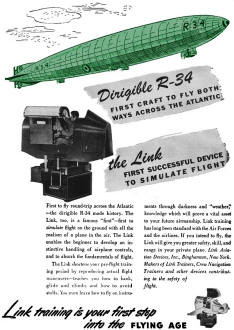|
This 1946 Popular Science
magazine ad trumpets the Link trainer as the first ground device that "feels"
like real flight. Drawing parallel with the Atlantic-crossing dirigible R-34, it
claims Link alone lets novices master controls, banks, climbs, stalls, and
instrument flying in darkness or weather - before leaving the ground. Used by
the Armed Forces and airlines, it cuts training time and boosts safety, the ad
says; if you want to own a private plane, Link training is "your first step into
the Flying Age." Engine instructor Ed Link cobbled together the first "Pilot
Maker" in a Binghamton, New York, garage during 1929 and peddled it as a
carnival novelty until the Army Air Corps - embarrassed by a spate of fatal 1934
airmail crashes - bought six trainers and turned them into WWII backbone that
taught half a million Allied pilots.
Link Flight Simulator - Dirigible R-34
 Dirigible R-34 Dirigible R-34
First Craft to Fly Both Ways Across the Atlantic
the Link
First Successful Device to Simulate Flight
First to fly round-trip across the Atlantic - the dirigible R-34 made history.
The Link, too, is a famous "first" first to simulate flight on the ground with all
the realism of a plane in the air. The Link enables the beginner to develop an instinctive
handling of airplane controls, and to absorb the fundamentals of flight.
The Link shortens your pre-flight training period by reproducing actual Right
maneuvers - teaches you how to bank, glide and climb; and how to avoid stalls. You
even learn how to fly on instruments through darkness and "weather," knowledge which
will prove a vital asset to your future airmanship. Link training has long been
standard with the Air Forces and the airlines. If you intend to fly, the Link will
give you greater safety, skill, and range in your private plane. Link Aviation Devices,
Inc., Binghamton, New York. Makers of Link Trainers, Crew Navigation. Trainers and
other devices contributing to the safety of flight.
Link training if your first step into the Flying Age
|




